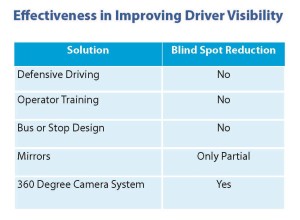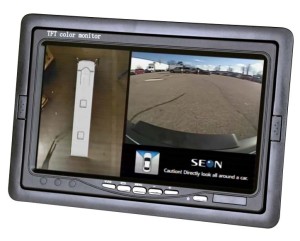Every vehicle has blind spots, but transit vehicles are particularly vulnerable to blind spots due to their size and composition. On a transit bus, blind spots not only impair driver visibility but often lead to deadly (and costly) collisions. Improving driver visibility can increase the safety of passengers and pedestrians and should be an integral part of any transit system’s safety program. But what are some solutions available today that help solve the killer blind spot? Let’s examine a few that have been tried to increase driver visibility and prevent common types of collisions.
Defensive Driving Techniques and Policies
Rock and Roll. Bob and Weave. No, these are not examples of the latest dance craze, but real-life strategies bus operators are trained to use to improve their visibility around the bus. These types of defensive driving techniques as well as policies on turning procedures are recommended to prevent pedestrian collisions in the Transit Cooperative Research Program (TCRP) Guidebook for Mitigating Fixed-Route Bus-and-Pedestrian Collisions.
The key behind this approach is to attempt to overcome and compensate for the presence of blind spots. Although mandatory turning procedures, such as no right turns on red lights or continual scanning when entering an intersection, have been reported to reduce the likelihood of a pedestrian accident, they do not materially improve driver visibility or eliminate the blind spots causing collisions, particularly those contributing to lane change crashes. Furthermore, some techniques such as square left turns or bobbing and weaving can take a toll on the operator’s body and increase disability rates.
Operator Training & Public Outreach
Another approach is to train both operators and pedestrians to be especially vigilant of potential bus blind spots and take steps to avoid collisions. Examples of this would be bus safety posters or decals with awareness messaging about staying alert and mindful of bus blind spots. Although this takes steps to reduce the risk of a pedestrian collision, or at least reduce the severity of injuries, the blind spots remain.
Bus Stop Design or Bus Modification
In some cases technology designed to improve safety, such as side mirrors or thick bus A-pillars, can create vehicle blind spots that are particularly dangerous for pedestrians. Use of smaller mirrors, or adjustments to their placement can improve driver visibility. At bus stops, better lighting can improve visibility at night, while increased sidewalk space and traffic control technology can help prevent the likelihood of pedestrian accidents.
Collision Avoidance Technology
 The most common technology used on transit buses to reduce blind spots is mirror technology. This can improve visibility along the left and right sides of the vehicle, but does not completely eliminate side of vehicle blind spots or improve rear views. Traditional back-up or rear-vision camera systems help with the rear view, but rear-backing scenarios and collisions are less common in a typical fixed bus route.
The most common technology used on transit buses to reduce blind spots is mirror technology. This can improve visibility along the left and right sides of the vehicle, but does not completely eliminate side of vehicle blind spots or improve rear views. Traditional back-up or rear-vision camera systems help with the rear view, but rear-backing scenarios and collisions are less common in a typical fixed bus route.
 One of the more promising emerging camera technologies to eliminate blind spots, is the around vehicle monitoring system, such as the recently introduced inView 360 product from Seon. With this technology, four cameras are strategically placed around the vehicle to capture an ultra-wide angle view of each side of the vehicle. These four views are blended and stitched together to give drivers a real-time, 360 degree bird’s eye view around the vehicle on a dash-mounted monitor. A split screen also displays a second view that changes depending on operating conditions. For example, when a driver employs the turn signal to change lanes this will change the view displayed on the right side of the monitor from the front view to the left or right side view.
One of the more promising emerging camera technologies to eliminate blind spots, is the around vehicle monitoring system, such as the recently introduced inView 360 product from Seon. With this technology, four cameras are strategically placed around the vehicle to capture an ultra-wide angle view of each side of the vehicle. These four views are blended and stitched together to give drivers a real-time, 360 degree bird’s eye view around the vehicle on a dash-mounted monitor. A split screen also displays a second view that changes depending on operating conditions. For example, when a driver employs the turn signal to change lanes this will change the view displayed on the right side of the monitor from the front view to the left or right side view.
Although data on the impact of this technology for preventing collisions is limited due to its relative infancy, a 2002 study on side view camera-based systems by the Florida Department of Transportation revealed a number of promising conclusions.
Wide-angle side view cameras were able to eliminate 100% of blind zones on the left and right sides, and provided better observation of boarding and late arriving passengers, and better lane change visibility. Camera systems also provided better visibility in dark conditions or inclement weather than mirror solutions. Finally a driver survey showed that a camera-based system provided an image that is simpler and faster to process and that drivers were quick to adapt to. Drivers reported feeling more confident in lane changes and believed it would reduce side crashes.
Although we’ll never eliminate transit bus collisions caused by operator fatigue and distraction, or pedestrian inattention, this new camera technology is so far one of the only ways to eliminate one of the deadliest of contributing factors in collisions – the blind spot.
Want to learn more about Seon’s inView 360 around vehicle monitoring system? To leave your request, visit our site

Lori Jetha
Marketing Manager, Seon
Lori.Jetha@seon.com


Great question, Kim. One of the best ways to stay in the loop is to stay connected with other professionals in the industry to be able to exchange opinions and share your challenges. For example, Seon has a great community of transportation professionals on social media – Facebook, LinkedIn, and Twitter, where you can share views and see what’s trending. Another way to keep up with technology is to check regularly industry magazines and publications, like School Bus Fleet or School transportation News. Every year, on the Seon Blog, we publish technology trends for the coming year, so if you are a subscriber you’ll get the news straight in your inbox. If you have some specific goals for your fleet, a good technology vendor will help you find the best solution depending on your transportation needs. Going to trade shows and seeing actual products in a booth might be another option.
How to keep up on all the technology ?
Hi Mark,
Thank you for your interest in Seon. Our team will contact your shortly to help with your request.
Looking for a camera system for 24 bus fleet